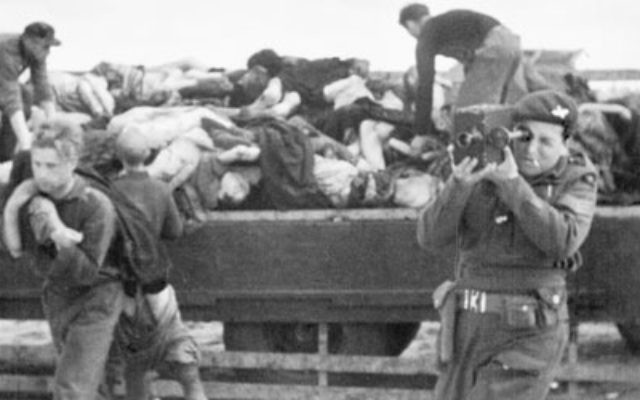Holocaust horror with Hitchcock touch
FILMMAKER Alfred Hitchcock was known as the master of horror and carved a career out of exploring the darkest depths of the human mind. But there was one true-life atrocity which even he could not bear to watch on the silver screen: the Holocaust.
In 1945, the acclaimed director of such thriller classics as Psycho, Rear Window and Vertigo was persuaded by his friend, Jewish director Sidney Bernstein, to leave Hollywood for England and collaborate on a documentary about German wartime atrocities in the Nazi death camps.
This followed a decision in April 1945 by the Supreme Headquarters Allied Expeditionary Force to make the film for screening in Germany after the fall of the Third Reich.
Much of the footage was shot by British, American and Soviet army film units. When British troops liberated Bergen-Belsen concentration camp in April 1945, the cameras were there to record the shocking scenes.
Dr Toby Haggith, restoration director at Britain’s Imperial War Museum, who supervised the project for the past few years, says the documentary was commissioned for propaganda purposes.
“The primary purpose of making the film was to show the Germans what the Nazis had represented and to undermine any lingering support for them, and that all Germans must be made to feel responsible for these atrocities,” he says by phone from London.
“It was also a propaganda film to show what the Allies did to try and bring these people back from the brink of death and recover their sense of dignity.”
Much of the footage was extremely graphic with a seemingly endless number of corpses. There were also shots of an abandoned train on a railroad that contained the snow-covered and frozen bodies of 3000 Jews. It was reportedly so horrific that Hitchcock was traumatised and stayed away from Pinewood Studios for a week.
While Hitchcock was only involved for about a month – between making Spellbound and Notorious – he made an important contribution.
“Interestingly, he was a feature film director brought in to work on a documentary, so he would bring a different conception to the project,” says Melbourne-born Haggith.
“Hitchcock had some important suggestions about the use of maps and how the film should be edited to avoid suggestions that it had been faked, but he didn’t oversee the editing of the rough cut.”
However, the documentary took far longer to make than had originally been envisaged. By September 1945, the project was shelved for fears it would harm Britain’s postwar relationship with Germany. The five rough-cut reels, plus a large amount of unedited footage of camp atrocities, were deposited in the Imperial War Museum, where they lay undisturbed for decades.
Hitchcock’s long career saw him pick up many prestigious awards, including two Golden Globes, five Academy Award nominations for best director and a knighthood just before his death in 1980, aged 80.
Some 40 years after the partly completed documentary about the Nazi camps was consigned to the museum vaults, the footage was stumbled across by a researcher.
The first five reels of the film were screened at the Berlin Film Festival in 1984, but had no sound and the entire sixth reel was missing. The final reel was reconstructed by the Imperial War Museum based on the original filming list and using unedited footage.
“For a long time we did not know what the title was going to be,” says Haggith. “We came across the original title as listed in the Information Catalogue of Films for Liberated Territories, published in September 1945 – German Concentration Camps Factual Survey – and decided to use it.
“It’s hardly a winner in Hollywood terms, but it is a very factual title that was supposed to be the final word on concentration camps and German atrocities.”
The 70-minute German Concentration Camps Factual Survey had its world premiere at the Berlin Film Festival in March.
Last month, the documentary was screened at the Jerusalem Film Festival and Haggith was there to introduce the film.
“It was important to screen the film in Israel because of the nation’s connection with the subject matter,” he says.
“There was a full house, mainly an older audience, and it was well received. Afterwards everyone was keen to discuss the film. People felt that it should be shown as widely as possible.”
He adds: “There have been many films about the Holocaust, but in this film the cameramen and editor tried to humanise those who had died.
“There are also scenes of rehabilitation of the survivors, which is unique among films of the Holocaust. The film presents hope for those in the documentary and for mankind.”
Haggith praised the work of the cameramen who were among the first inside the camps with the liberation forces, and who filmed instinctively without any directors on the spot.
“Much of their footage is shocking, but they did it because it would also be used as evidence in any criminal proceedings against the Nazis, as well as to broadcast to the world what had taken place.”
The original narration was also preserved – including its factual inaccuracies and some historical and political biases – with a voiceover by actor Jasper Britton.
“It’s a lost masterpiece of British documentary cinema,” says Haggith, who will be in Melbourne for the film’s screening along with Canberra author Helen Lewis, daughter of armed forces cameraman Mike Lewis, who filmed at the liberation of Bergen-Belsen.
German Concentration Camps Factual Survey screens at the Melbourne International Film Festival on August 9 and 10. Bookings: www.miff.com.au and as a JIFF special event at Bondi Junction Event cinemas on August 19 and 20 at 7pm, followed by a Q&A with Toby Haggith, Konrad Kweit and Danielle Celermajer. Bookings: www.jiff.com.au.
REPORT by Danny Gocs
PHOTO of Allied cameraman Sergeant Mike Lewis filmING at Bergen-Belsen concentration camp on April 24, 1945. Photo: Imperial War Museums


comments